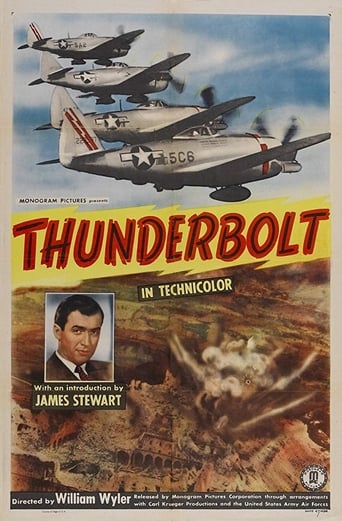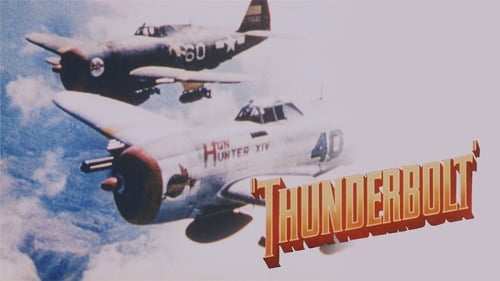


Waste of time
... View MoreI wanted to like it more than I actually did... But much of the humor totally escaped me and I walked out only mildly impressed.
... View MoreThis story has more twists and turns than a second-rate soap opera.
... View MoreThe best films of this genre always show a path and provide a takeaway for being a better person.
... View MoreWilliam Wyler began work on this film during 1944 as a counterpoint to his better-known film about the 8th Air Force, "Memphis Belle". While the latter concerned the strategic bombing campaign carried out by long-range, multi-engine bombers, the subject of "Thunderbolt" was tactical missions flown by single-engine, single-seat fighter-bombers. This was a very different war from that depicted in "Memphis Belle". For one thing, while strategic bomber crews could expect to be rotated home after completing 25 missions, the fighter-bomber pilots were flying literally hundreds of missions, frequently carrying out several during the course of a single day. The film chronicles a brief period with one of several fighter-bomber groups based on the island of Corsica, about 60 miles west of the Italian mainland. Incidentally, this was the same island where Joseph Heller was based, and which inspired him to write his famous novel, "Catch-22". The only difference is that "Thunderbolt" was not filmed with a Medium Bomber Group, such as Heller served in, but with a Fighter-Bomber Group. The fighter-bombers featured in the film are P-47s, to which the Army Air Force gave the emotive name of "Thunderbolt". However, to those who flew them, the P-47 was invariably known as "The Jug", partly due to it's rotund shape, but more especially as a contraction of the word "Juggernaut". For a Juggernaut was precisely what the P-47 was. The Jug was the largest single-seat fighter to serve during WW-II. It carried eight 12.7-mm machine guns along with a heavy load of bombs or rockets, and was capable of bringing it's pilot home after absorbing a considerable amount of battle damage. Unlike any other fighters of that time the Jug had an air-cooled engine, which meant that it's pilot did not have to worry about a liquid cooling system that was vulnerable to damage from enemy fire. Because of those characteristics the Jug came into it's own in the sort of low-level ground-attack missions shown in "Thunderbolt". In fact years later, when they began flying similar ground attack missions in Korea, a lot of veteran pilots regretted the fact that the Air Force had seen fit to scrap all of it's Jugs after WW-II ended."Thunderbolt" does not glamorize the lives of these fighter-bomber personnel. The narration is as terse as the subject matter. It was a brutal war, and that brutality is not watered down. To the men of the Fighter-Bomber Group this was merely a day-to-day job, with the difference that the working men shown in the film did not always live to see the next day. However, the film does go out of it's way to explain exactly what it was that they were trying to accomplish, and why it mattered. It is interesting to reflect that The Big Picture was something many of the members of the Fighter-Bomber Group probably did not entirely understand at the time. In short, these aircraft were engaged in cutting Italian road and rail communications in order to prevent the movement of war material to the German Army, so that the Allied Armies could break the stalemate in the mountains of Southern Italy. The mere fact that the stalemate was broken is proof of how effective the air campaign shown in the film actually was.
... View MoreIt's a pretty brutal picture of the pilots of the P-47s that flew out of Corsica on ground attack missions to the Italian mainland. There are reasons why it shouldn't have been shown at home. American boys injured, crashing and dying; barns and auxiliary buildings blown up just in case they might be harboring something inimical to our interests. I don't know if it would have been stifled or not. John Huston had all sorts of problems with his "Battle of San Pietro" because it showed American dead being folded into mattress covers.That it WAS, in fact, made during the war is reflected in the sometimes bitter commentary, suggesting that the Italians and Germans deserved everything they got. There are some "good Germans" on Corsica, followed by a shot of a dilapidated graveyard.It's all color footage. We follow the young men around as they get out of bed and prepare themselves for another mission. The narration, by Lloyd Bridges, explains what's going on in a clipped, hypermasculine way. "Time for the briefing. Don't know what mission it is. Don't always care." The maps and associated graphics are simple enough for a child to understand.The missions involved bombing, rocket launching, and strafing, and the P-47 appears to have been built for it. It was a huge, powerful, fast single-engine, single-seat fighter that could carry an enormous load of ordinance and could take a punishing amount of damage. It carried eight .50 caliber machine guns, and we see a good deal of strafing from the gun cameras. A line of spurts tracks a target and envelopes it in dust. A shot, not shown here, that I've seen only once, has a hapless French farmer on a cart galloping his horse down a country road. Cart, farmer, and horse disappear in the cloud. And what carries much of the impact is not the farmer being killed, because we've seen humans shot and killed so often we've been desensitized. It's the horse, the poor innocent horse.There is another documentary about a pilot, Quentin Annenson, who flew P-47s in the European theater. Annenson narrates the film himself in his quiet Minnesota accent. It's longer, more personal, more detailed, and utterly gripping.
... View More"Thunderbolt" is a 42-minute documentary that was made shortly after World War II. There are some big names associated with this project such as James Stewart, Lloyd Bridges, William Wyler or John Sturges. It is about airplanes during the days of war and how American pilots were good enough to make a lasting impact thanks to ability and technology. Sometimes, it also gets concrete in terms of particular strikes during these days of war. I myself am more interested in the political aspects of these dark days than in technical factors. Also, this film got a tad too patriotic occasionally for my taste. It is not a bad film by any means and can be informative if you have an interest in the subject, but it's just such a particular area that most probably won't. All in all, I was not impressed watching this.
... View More*Spoiler/plot- 1947, A film showing the operations of a fighter/bomber air wing group flying from Sardinia to Italy to support the Italian Allied campaign.*Special Stars- Director: John Sturges. Narrator: Robert Lowery. Pilot's voice: Lloyd Bridges *Theme- Airpower is crucial in operations.*Trivia/location/goofs- Filmed in Sardinia. Look for the best film representations of Christmas holidays celebrated in the rear areas by troops of the WW2 period.*Emotion- An enjoyable documentary made up of live action combat or newsreel footage. It gives you the tone and feel of the times for WW2 fighter pilots. However, there are the unpleasant shots of injured Americans with some blatant racist language. But it is extremely educational and does what a narrative simulated war film can do.
... View More